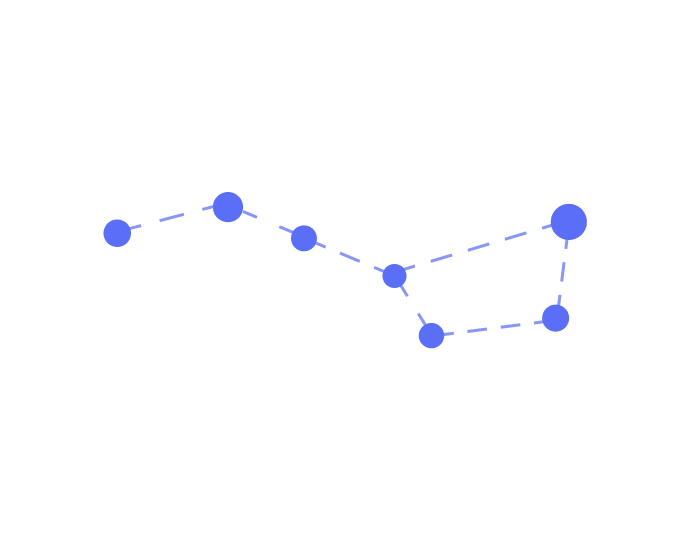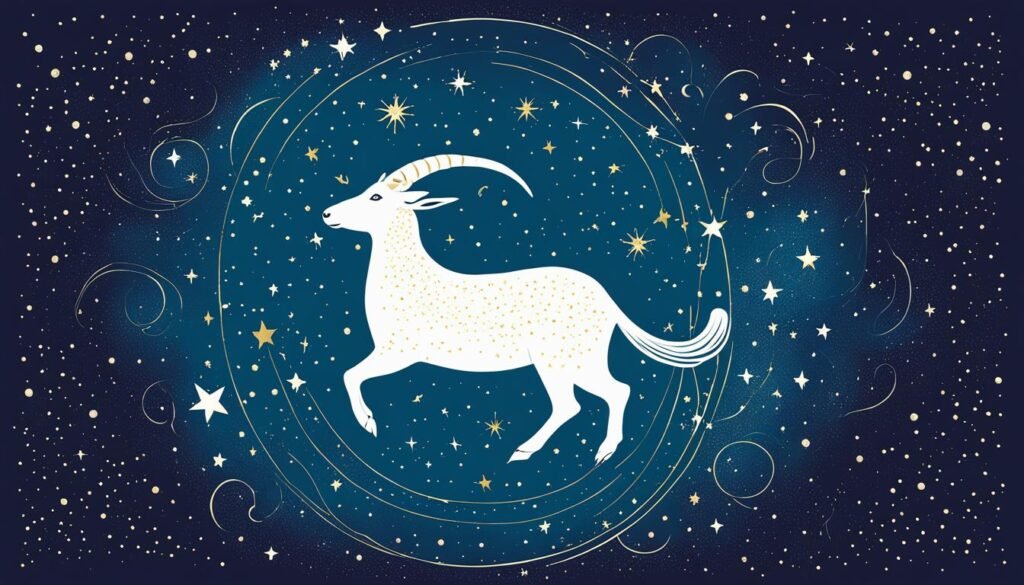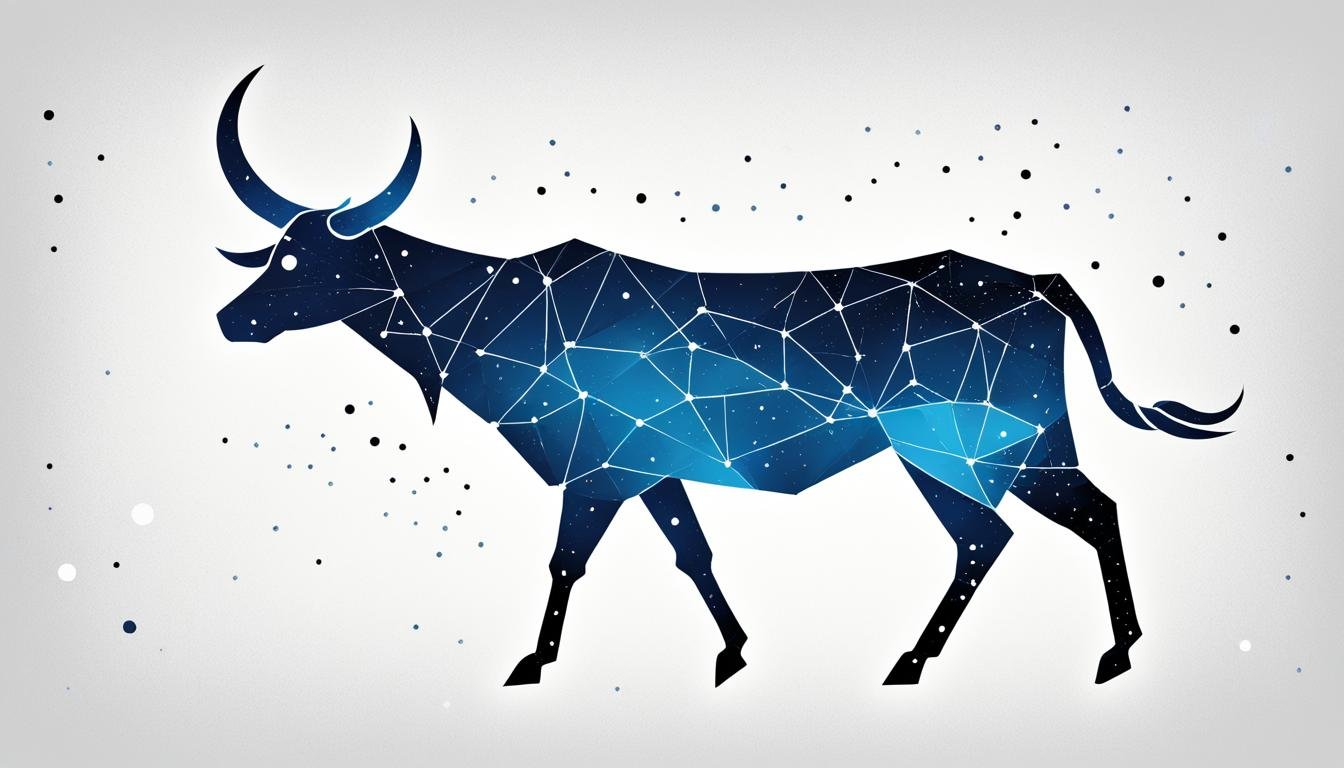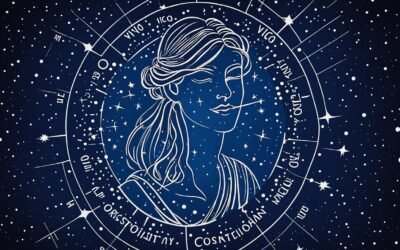
| Genitive | Capricorni |
| Abbreviation | Cap |
| Pronunciation | /ˌkæprɪˈkɔːrnəs/ |
| Main Stars | Aprox. 9 |
| Brightest Star | Deneb Algedi (δ Cap) |
| Right Ascension | 20h |
| Declination | -20° |
| Sq. Deg. Area | 414 |
| Crosses Meridian | 9PM, Sep |
| Visible Lat. Range | +60° to -90° |
| Best Viewing Season | Late Summer (Northern Hemisphere) |
When you gaze into the southern sky, the constellation Capricornus unveils a tapestry interwoven with celestial wonder and rich mythology. Known as “the goat” in Latin, this constellation beckons stargazers and astronomers alike to explore its intricate Capricornus star pattern and navigate its revered star map. Reminiscent of a mythical sea goat, Capricornus firmly anchors itself in the heavens, offering insight into not only the constellatory alignment but also the fabric of ancient stories that surround this Capricorn celestial body. Cataloged by the famed Greek astronomer Claudius Ptolemy in the 2nd century CE, it’s a gateway to observing some of the sky’s most notable stars and deep-sky objects. Whether you’re an avid sky watcher or a curious beginner, the Capricornus star map is your atlas to unlocking the secrets held within this celestial jurisdiction.
Key Takeaways
- The Constellation Capricornus is a storied presence in the night sky, symbolizing the sea goat and capturing celestial drama through its distinctive stars.
- Dating back to ancient civilizations, the Capricornus star pattern is rooted in mythological tales, featuring gods like Enki and Pan.
- The Capricornus star map serves as an astronomical guide, leading observers to discover notable stars such as Delta Capricorni and Beta Capricorni.
- Best viewed in September, the Capricorn celestial body is observable from both the Northern and Southern Hemispheres.
- With a sprawling area of 414 square degrees, mapping Capricornus unlocks a new dimension of stargazing experience.
- Lying in the fourth quadrant, Capricornus’s standout features enrapture the minds of astronomers past and present.
- The capacious Capricornus constellation is an essential piece to understanding the historic and present cosmic landscape.
The Mythological Legacy of Capricornus
Embedded within the stars, the constellation of Capricornus holds a tapestry of tales that stretches across ancient civilizations. One such narrative belongs to the Babylonian myth, where Capricornus first emerges as the goat-fish, a venerated emblem of the god Ea. This merger of caprine and ichthyic forms has basked in the celestial limelight for millennia, whispering stories of the symbiosis between the essence of the earth and the unfathomed depths of water.
As your gaze pierces through the veil of the cosmos toward this storied constellation, you encounter the exhilarating Greek myths that add layers to Capricornus’s legend. Here, the Pan god of the wild, famed for his feral spirit and rustic melodies, metamorphoses into the sinewy form of a sea goat to elude the malevolent clutches of the fearsome Typhon. The narrative threads of Greek mythology weave Pan into the fabric of the stars, forever imprinting his dual nature as an enduring symbol of resilience and transformation.
The constellation also pays homage to the nurturing Amalthea goat, the tender foster-mother of Zeus, whose milk guided the growth of a god destined for Olympus. It is within the embrace of this cosmic creature that the narratives of survival and sustenance unite, showcasing the constellation’s role as a celestial cradle in the Greek mythological expanse.
| Mythological Figure | Culture | Symbolism | Connection to Capricornus |
|---|---|---|---|
| Goat-fish | Babylonian/Sumerian | Renewal and Fertility | Early depiction of the constellation as a symbol of god Ea |
| Pan (god of the wild) | Greek | Music, Rustic Life, and Escape | Transformation into sea goat, representation in stars |
| Amalthea | Greek | Nourishment and Support | The goat that fed Zeus, symbolic of provisions and care |
Exploring Capricornus through the lens of mythology illuminates the profound connection between ancient cultures and the celestial pantheon. The evolution of its image from a Babylonian deity’s symbol to a hiding place for a Greek god reveals the enduring power of these celestial stories. As you tilt your head skyward to witness the convergence of land and sea in the stars, Capricornus offers a silent testament to humanity’s timeless quest for meaning amid the cosmos.
Constellation Capricornus: Mapping the Sea Goat in the Night Sky
To unlock the mysteries of the constellation Capricornus, you must venture into the art of celestial navigation. The night sky is your canvas, upon which Capricornus paints a faint yet distinctive pattern resembling a mythical sea goat. Whether you’re an amateur stargazer or an experienced astronomer, locating this southern zodiacal constellation offers both challenge and reward. With this guide, night sky mapping becomes a gateway to the wonders of the cosmos, as you trace the paths of Capricornus’s major stars.

Finding Capricornus: The Search for the Sea Goat
Embarking on the journey to locate the Capricornus constellation begins by seeking its place among the surrounding constellations. Use Pegasus, Aquila, Sagittarius, and Piscis Austrinus as your celestial landmarks. Despite its dimness, Capricornus’s unique feature of two horn-like patterns—a signature of the constellation—can help you in your search. During the Northern Hemisphere’s summertime or Southern Hemisphere’s wintertime, Capricornus’s visibility improves, allowing for clearer Capricornus star identification.
Deneb Algedi: The Luminary of Capricornus
The star known as Deneb Algedi shines as the Capricornus brightest star, marking the tail of the sea goat and serving as a crucial stellar marker. This celestial beacon, approximately 39 light-years away, is a system composed of multiple stars, including a fascinating eclipsing binary. Its Arabic-derived name, indicating “tail,” underscores its importance in the constellation’s formation and helps with pinpointing this intricate cosmic arrangement.
Beyond the Brightest Stars: Mapping the Rest of the Sea Goat
Moving past Deneb Algedi, a collection of significant stars contributes to the full depiction of the sea goat in the sky. Delta Capricorni offers its own luster, while prominent names such as Alpha Capricorni—also called Algedi—and Gamma Capricorni, known as Nashira, shine from afar. Each star plays a role in not only forming the constellation’s shape but also in catching your gaze with their varied luminosities and distances, adding depth to your night sky mapping endeavors.
Capricornus in the Context of Zodiac Constellations
Those familiar with Capricorn astrology may recognize the substantial influence that the Capricornus zodiac sign has on individual horoscopes. As you delve into the realm of Capricorn horoscope readings, you’ll find Capricornus nestled among the classical circle of zodiac constellations, which includes Aries, Taurus, and Gemini. This celestial segment has been pivotal in astronomy and astrology, historically pinpointing the beginning of the winter season as it heralds the sun’s position in Capricorn.
As a defining constellation within the zodiac family, Capricornus’s symbolism and positioning play an integral role in the astrological calendar. Beyond mere stargazing, the constellation’s alignment and movements provide astrologers with the celestial canvas to craft predictive insights into one’s personality traits, potential life events, and various aspects pertaining to earthly existences.
Below is a comparative chart that further illustrates Capricornus’s uniqueness among its zodiacal counterparts:
| Zodiac Sign | Element | Quality | Ruling Planet | Season Initiation |
|---|---|---|---|---|
| Capricorn (Capricornus) | Earth | Cardinal | Saturn | Winter |
| Aries | Fire | Cardinal | Mars | Spring |
| Taurus | Earth | Fixed | Venus | Spring |
| Gemini | Air | Mutuable | Mercury | Spring |
With its distinctive qualities, the Capricornus zodiac sign stands out as not just a mere constellation, but as an ancient symbol deeply entrenched in astrology’s rich tapestry. Understanding its place in the skies may offer you a deeper appreciation for Capricorn’s profound connection to our seasonal rhythms and astrological insights.
Astronomical Wonders within Capricornus
Delving into the Capricornus constellation facts, we uncover a realm rich with celestial phenomena. Your deep sky exploration of this ancient constellation will reveal an array of stellar curiosities, form the dynamics of binary systems to the grand composition of distant clusters.
The Eclipsing Binary of Delta Capricorni
A standout feature within Capricornus is the eclipsing binary system, Delta Capricorni. Comprised of a bright primary star and its fainter companion, this duo performs a captivating cosmic waltz. The primary, a white giant Delta Capricorni Aa, dominates, periodically dimming as its partner orbits and eclipses it, producing a notable fluctuation in brightness visible from Earth.

Exploring the Depth of Capricornus: Messier 30 and Other Deep-Sky Objects
Capricornus is also the guardian of deep-sky treasure Messier 30, a globular cluster nestled within its borders. This tightly bound sphere of stars is a spectacle that can be enjoyed with even modest telescopic equipment. Alongside, the compact galaxy trio known as HCG 87 presents a skywatcher’s riddle, with interactions hinting at eventual coalescence, further accentuating the mysteries housed in the constellation.
The Intriguing Interactions of Star Systems in Capricornus
Another astronomical highlight is the Beta Capricorni system, a stellar ensemble featuring principal components Dabih Major and Dabih Minor. This multi-star setup is a brilliant representation of star system interactions within Capricornus. Despite the immense distances separating these luminaries, their gravitational links choreograph an intricate celestial dance, showcasing the dynamic and complex Capricornus stellar composition.
Whether you’re charting the dance of eclipsing binaries, scanning the galactic clusters, or mapping the gravitational symphony of star systems, Capricornus offers a feast for the eyes and the imagination, serving as a perfect backdrop for your stargazing adventures.
Nautical Navigation and Agricultural Ancient Needs: Capricornus’s Historical Uses
Amidst the tapestry of night sky, the Capricornus constellation has long since been a beacon for civilizations past. Its stars, steady and unwavering, have served as more than just celestial ornamentation—they’ve been instrumental in guiding human endeavors, from the precision of ancient seafaring to the organization of agricultural calendars. As you gaze upon its spread across the sky, consider the ways in which Capricornus has rooted itself in the history of our ancestors’ survival and daily life.
The Winter Solstice and the Tropic of Capricorn
Once a celestial herald of the winter solstice, the positioning of Capricornus was integral to the demarcation of the Tropic of Capricorn. Although the slow march of axial precession has altered the skies since the Early Bronze Age, this constellation’s traditional winter solstice placement still resonates with us, immortalized in the Tropic’s very name. This event in historical astronomy was more than a natural phenomenon; it was a cornerstone in understanding our planet’s delicate dance with the sun.
The Impact of Capricornus on Ancient Maritime Travel
In the realm of ancient seafaring, the stars of Capricornus provided more than light. They were invaluable for navigational reference points for travelers traversing the unpredictable seas. With astronomical mapping, mariners sought guidance from these stars, ensuring they remained on course through their night voyages, making the pattern of Capricornus synonymous with safety and direction amidst the vast ocean expanses.
Agricultural Calendars and the Capricornus Constellation
Agricultural societies relied on the heavens as much as they did on the earth. The emergence of Capricornus was pivotal for timing the sowing and reaping of crops, as well as for planning communal festivities. This agricultural astrology reflected the deep connection between the cosmos and the sustenance of life. Indeed, the constellation’s seasonal significance was etched into historical calendars, framing the rhythm of annual labor in the fields and pastures.
FAQ
What is the constellation Capricornus and where can it be found?
The constellation Capricornus, also known as the Capricorn, is a constellation in the southern sky with a name meaning “the goat” in Latin. Depicted as a sea goat, it sits in the fourth quadrant of the southern hemisphere and is visible at latitudes between +60° and -90°. It is best observed in the month of September.
What is the mythological significance of Capricornus?
Capricornus carries a rich mythological history and is often associated with the Greek god Pan, the deity of the wild known for transforming into a goat with a fish tail. It also ties back to the Babylonian god Ea and the nurturing goat Amalthea from Greek mythology. The constellation symbolizes a fusion of terrestrial and aquatic life across various cultures.
How can you locate the Capricornus constellation in the night sky?
To find the Capricornus constellation, you can look for its distinctive pattern that resembles two horns using stars from neighboring constellations. Stars from Pegasus, Aquila, Sagittarius, and Piscis Austrinus can help locate Capricornus, which is best observed from the Northern Hemisphere during summertime and from the Southern Hemisphere in wintertime.
Which star is the brightest in the Capricornus constellation?
Deneb Algedi is the brightest star in the Capricornus constellation. It is a multiple star system, which includes an eclipsing binary star, approximately 39 light-years from Earth.
What is the significance of Capricornus in astrology?
In astrology, Capricornus is connected to the Capricorn zodiac sign and forms part of the classical zodiac circle, which also includes Aries, Taurus, Gemini, and others. It traditionally marked the winter solstice and now signifies the sun’s position at the start of winter for the modern Capricorn horoscope.
What are some astronomical wonders found within Capricornus?
Capricornus is home to several astronomical wonders, such as the globular cluster Messier 30 and the compact galaxy group HCG 87. The eclipsing binary star system Delta Capricorni is also a prominent feature, known for its cyclical light variations due to the orbiting stellar components.
How did Capricornus impact nautical navigation and agricultural needs in history?
Capricornus was crucial for ancient seafarers who used its stars for nighttime navigation, helping to determine their position and direction at sea. In agricultural societies, the constellation’s visibility was key for timing farming activities and defining ancient calendars, establishing crucial temporal landmarks for crop cultivation throughout the year.
Why is the Tropic of Capricorn named after the constellation?
The Tropic of Capricorn is named after the constellation because it historically marked the position of the winter solstice during the Early Bronze Age. Though precession has shifted this alignment over the millennia, the tropic’s name remains a nod to the constellation’s traditional place in the solstice sky.
Can you explore deep-sky objects within Capricornus with amateur telescopes?
Yes, some deep-sky objects within Capricornus, like the globular cluster Messier 30, can be observed with amateur telescopes. However, viewing conditions and equipment quality will affect the level of detail you can see.
How are the stars in the Beta Capricorni system significant?
The Beta Capricorni star system is significant due to its multiple stars, including Dabih Major and Dabih Minor, which exemplify complex gravitational interactions. The system showcases the dynamic and intricate nature of stellar relationships within the constellation.






